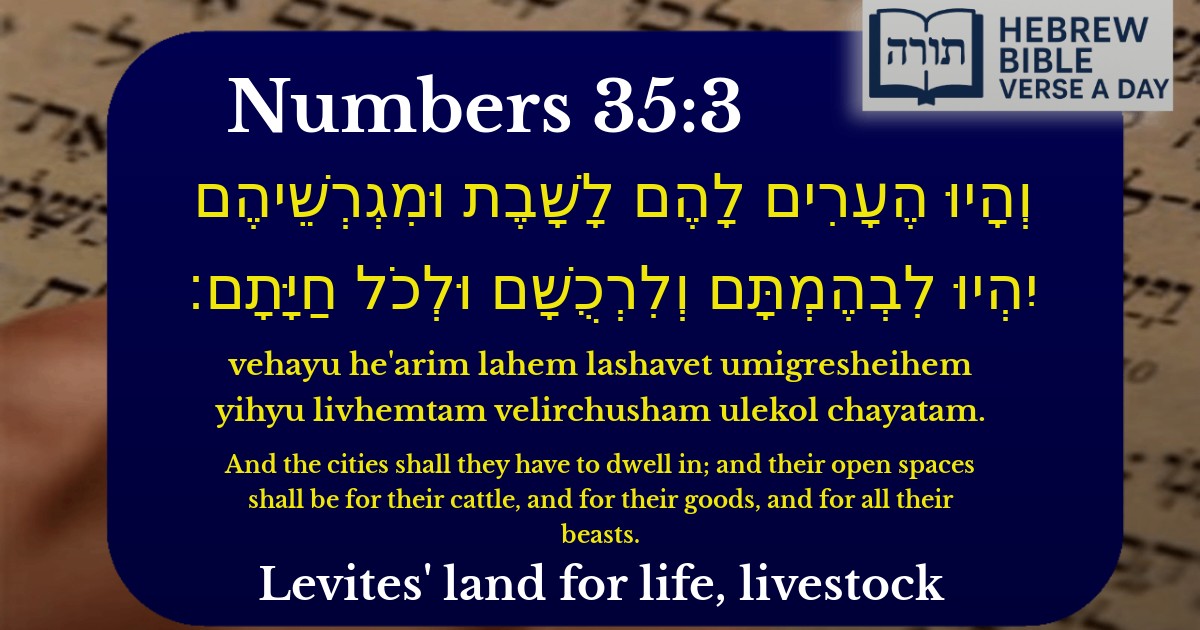Frequently Asked Questions
Q: What does Numbers 35:3 mean?
A: Numbers 35:3 discusses the allocation of cities to the Levites, who did not receive a portion of land like the other tribes. The verse specifies that while the Levites would live in the cities, the surrounding open spaces (migrashim) would serve as pastureland for their livestock and possessions. Rashi explains that these open spaces were essential for their livelihood, as the Levites were dedicated to serving in the Mishkan (Tabernacle) and later the Beit HaMikdash (Temple).
Q: Why were the Levites given cities and open spaces?
A: The Levites were given cities and surrounding open spaces because, unlike the other tribes, they did not receive a territorial inheritance in the Land of Israel (Numbers 18:20). Their role was to serve in the Mishkan and teach Torah to the people. The open spaces allowed them to sustain themselves with livestock and agriculture while fulfilling their spiritual duties. The Rambam (Hilchot Shemitta 13:12) emphasizes that the Levites' primary focus was Torah and Divine service, and these cities ensured their material needs were met.
Q: What can we learn from Numbers 35:3 today?
A: This verse teaches the importance of providing for those who dedicate their lives to spiritual and communal service. Just as the Levites were given cities and pastureland to sustain them, today’s Torah scholars and teachers also rely on community support to continue their work. The Talmud (Nedarim 62a) states that one who benefits from Torah scholars merits a share in their reward, highlighting the mutual responsibility between teachers and the community.
Q: How were the Levite cities different from regular cities?
A: The Levite cities were unique because they served both as residential areas and as refuge cities (arei miklat) for accidental killers (Numbers 35:6). Additionally, the open spaces around them could not be sold permanently (Leviticus 25:34), ensuring the Levites always had land for their needs. The Sifrei (a halachic Midrash) notes that these cities were distributed evenly across Israel so that the Levites could teach Torah in every region.
Q: Why does the Torah mention cattle and possessions in this verse?
A: The Torah specifies that the open spaces were for the Levites' cattle, possessions, and animals to emphasize that these areas were designated for practical, livelihood purposes. Unlike agricultural land given to other tribes, the Levites' land was primarily for grazing and storage. The Midrash Tanchuma (Bamidbar 35) explains that this arrangement allowed the Levites to focus on their spiritual roles without neglecting their physical needs.


Context in the Torah
This verse appears in Bamidbar (Numbers) 35:3, within the context of the commandment to designate cities for the Levites, who did not receive a territorial portion in the Land of Israel like the other tribes. The verse specifies that while the Levites would dwell in these cities, the surrounding open lands (migrashim) would serve practical purposes for their livestock and possessions.
Rashi's Explanation
Rashi (Rabbi Shlomo Yitzchaki) comments that the term migrashim refers to open spaces surrounding the Levitical cities, extending outward for a distance of 1,000 cubits (approximately 500 meters) in all directions. These areas were not to be used for agriculture or construction but were reserved for grazing livestock and storing goods. Rashi emphasizes that this arrangement ensured the Levites could sustain their households without engaging in farming, allowing them to focus on their spiritual duties in the Mishkan (Tabernacle) and later the Beit HaMikdash (Temple).
Rambam's Legal Perspective
In Hilchot Shemittah v'Yovel (13:2-3), the Rambam (Maimonides) elaborates on the halachic dimensions of the migrashim. He rules that these open spaces were inviolable: they could not be sold permanently, converted into fields, or built upon. This prohibition reinforced the Levites' unique role, as their livelihood depended on these designated lands for pasture and storage, in lieu of agricultural inheritance.
Midrashic Insights
Practical and Symbolic Significance
The Kli Yakar (Rabbi Shlomo Ephraim Luntschitz) highlights the duality of this commandment: while the migrashim served practical needs, they also symbolized the Levites' detachment from materialism. By relying on communal support and these open lands, the Levites embodied trust in Divine providence, a model for all Israelites in prioritizing spiritual over material pursuits.